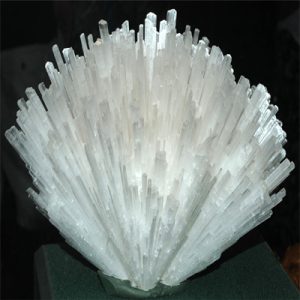Scolecite
Scolecite is a member of the Zeolite Group of minerals that includes over 40 minerals and these gem-type minerals: Analcime, Barrerite, Chabazite, Epistilbite, Gmelinite-Na, Goosecreekite, Mordenite, Natrolite, Pollucite, Scolecite, Stellerite, Stilbite, Thomsonite and Yugawaralite. Scolecite is not a rare mineral but crystals large enough for faceting are very rare and usually kept as mineral specimens by collectors. The small number of faceted gems that exist are usually small and colorless. Chatoyant cabochons are occassionally available. Scolecite is pyroelectric and piezoelectric. Current sources of Scolecite crystals are in the Poona, Nasik, and Bombay districts, Maharashtra, India; and near Bento Goncalves, Rio Grande do Sul, Brazil. Non-gem specimens can be found in the USA on the south fork of the Toutle River, Cowlitz Co., in the Pioneer quarry, Bremerton, Kitsap Co., and other localities in Washington; and on North Table Mountain, Golden, Jefferson Co., Colorado.
| Category: | Silicate mineral |
| Formula: | CaAl2Si3O10·3H2O |
| Crystallography: | Monoclinic – Domatic |
| Crystal Habit: | Crystals are slender prismatic, may be square in cross section, elongated and striated, to 30 cm. Characteristically in radiating sprays, fibrous masses; nodular, massive. Twinning: On [100], twin axis [001], common, as contact or penetration twins. |
| Cleavage: | [110] Perfect |
| Fracture: | Uneven |
| Tenacity: | Brittle |
| Moh’s Hardness: | 5.0 – 5.5 |
| Density: | 2.16 – 2.40 (g/cm3) |
| Luminescence: | May fluoresce yellow to brown under SW and LW UV |
| Radioactivity: | Not Radioactive |
| Color: | Colorless, White, Pink, Salmon, Red, Brownish, Green |
| Transparency: | Transparent to Subtransparent |
| Luster: | Vitreous, Silky |
| Refractive Index: | 1.507 – 1.521 Biaxial ( – ) |
| Birefringence: | 0.010 |
| Dispersion: | Relatively Strong; r < v |
| Pleochroism: | None |


